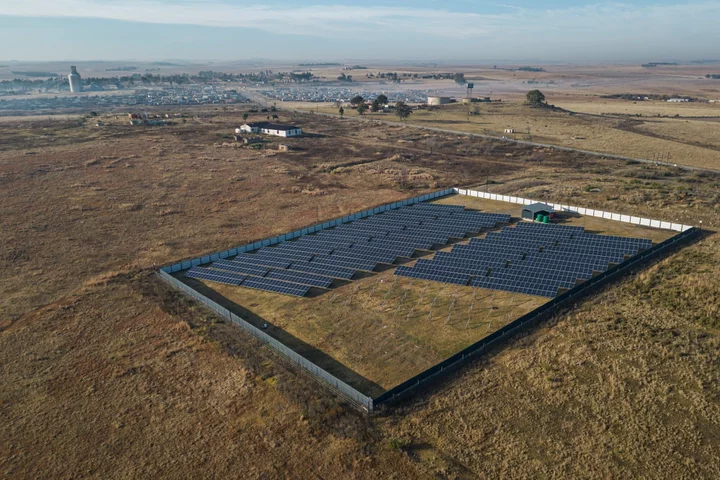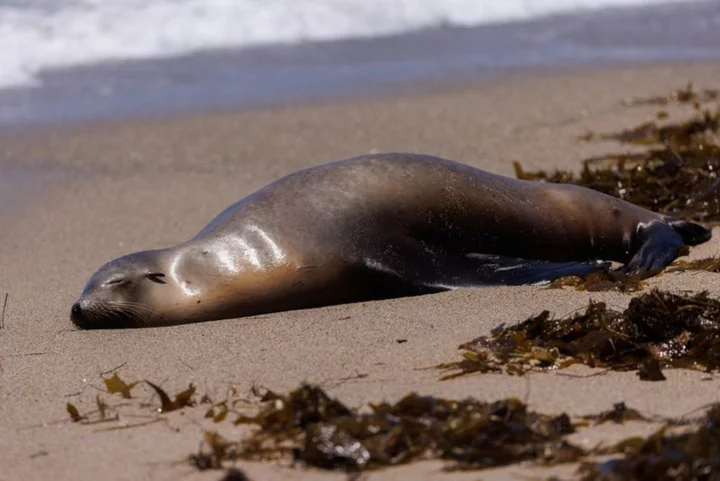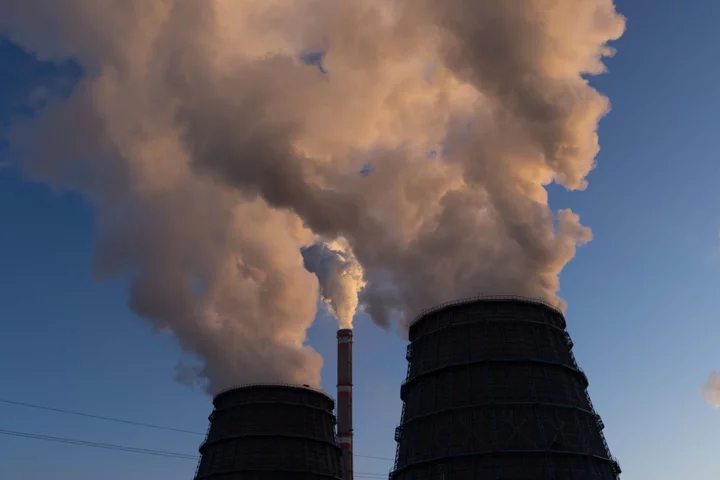The snake and armadillo-filled scrublands of Northeastern Brazil’s Serra da Babilonia, or Hills of Babylon, are as stunning as a first-rate national park. It’s here where renewable energy is transforming Brazil, and where the country’s green hydrogen economy is getting off the ground.
Wind developer Casa dos Ventos just installed 80 turbines. The towers churn out enough power for a small city, but that’s not where it’s going. The main buyer is chemicals producer Unigel, which will use it to split water molecules and make hydrogen at a port on Bahia’s coast.
“We see Brazil as a leader in the green hydrogen economy for one main reason: the availability of renewable energy,” said Unigel Executive Director Luiz Felipe Fustaino.
Unigel will turn the hydrogen into green ammonia, becoming Brazil’s first exporter. Ammonia made from coal or natural gas is one of the most common industrial chemicals and is used to make fertilizer, plastics and textiles. Green ammonia allows Brazil to take its renewable power to the wider world. Unlike electricity that relies on transmission lines, ammonia can be chilled, stored, and then shipped to clients. Casa dos Ventos is part of another venture with partners including TransHydrogen Alliance and the Port of Rotterdam to export even larger volumes to Europe.
Renewable energy is one of the fastest-growing businesses in a country saddled with six-year-high interest rates. Wind and solar capacity grew 260% from 2017 through 2022, and it continues to surge thanks to projects like those in Babilonia.
Global demand for green hydrogen could spur more growth. Global hydrogen consumption needs to more than quintuple to 500 million metric tons in 2050 for worldwide emissions to reach net zero, according to BloombergNEF. If the hydrogen surge happens, it will transform some of the most-difficult-to-clean chunks of the global economy, such as agriculture, marine transport, steel-making, oil refining and even aviation.
Brazil is poised to take advantage of the moment. It has the cheapest wind energy in the Americas because of the consistently strong winds at places like Babilonia, and its location gives it an edge. The northeastern coast is strategically positioned for exports to Europe, and even including shipping costs, Brazilian green ammonia is cheaper than subsidized production of the chemical in Germany, according to BloombergNEF. Private companies and state governments are already looking to turn the region into a green hydrogen hub.
“This new hydrogen industry is going to drive more buildup of renewables,” said Natalia Castilhos Rypl, a BloombergNEF analyst covering green hydrogen in Latin America. “It’s a good sign for renewable developers.’’
Still, there’s plenty of room for Brazil to mess up this new phase of the energy transition. Unlike Chile, which has the second-cheapest wind energy in the region, Brazil hasn’t set up a national plan for green hydrogen with targets and incentives. The country’s congress is still hammering out legislation for offshore wind, green hydrogen and carbon markets, which most developers are waiting on to pull the trigger on multi-billion-dollar investments. If Brazil doesn’t act fast, other countries will build supply chains first. Unigel would rather sell the green ammonia locally, but there’s no policy in place to reward buyers of the chemical.
The government, along with the state-controlled oil giant Petrobras, also plans to increase production of natural gas from offshore fields to bring prices down by as much as half, which would compete with renewable energy for both the production of electricity and hydrogen.
Brazil is one of the few countries eligible for preferential trade terms when selling hydrogen to Europe because of the dominance of renewables. If the country builds more natural gas plants, fossil fuels will take a bigger share of the power grid and Brazil could lose its preferential status, according to Rypl, the BloombergNEF analyst.
Read more: Latin America’s Big Green Hydrogen Export Dreams May SlipBrazil may also wind up competing with cheap US green hydrogen, heavily subsidized by the Inflation Reduction Act. The idea is that American buyers will snap up the fuel, but if there aren’t enough domestic customers, it could flood the export market.
If Latin America’s biggest country gets it right, green hydrogen will allow it to transition away from an oil industry that is set start declining in the 2030s. Brazil can make the cheapest green hydrogen in the world excluding subsidies, according to BloombergNEF.
To succeed, the government needs to exclude it from export taxes, fast track the licensing of transmission lines, and encourage equipment sellers to build more plants in Brazil, said Antonio Bastos, chief executive officer of Omega Energia SA, a Brazilian renewable energy company. “Brazil can be the Saudi Arabia of green hydrogen,” he said. “We can compete with the US without any of the subsidies.”
Brazil’s first wind turbine was installed in 1992, but it took 15 more years for turbine construction to really accelerate. In 2017 the cost of wind fell below hydropower, and large companies started taking advantage of Brazil’s business-friendly regulations to buy renewable electricity directly from large wind producers.Brazil is blessed with wide-open spaces in the windiest parts of the country and an interconnected national power grid, which makes it easier to produce clean energy in remote locations and consume the equivalent amount of electrons closer to major population centers. That’s why Brazil’s renewable energy industry was able to flourish even under Jair Bolsonaro, the former president known for encouraging deforestation in the Amazon and prioritizing fossil fuels.Installed wind capacity nearly doubled under his watch. It’s surging still, and his successor, Luiz Inacio Lula da Silva, has big plans to attract billions of dollars to develop offshore wind facilities and provide power for a second phase of green hydrogen development.
The first offshore parks could start operating in 2030. But first Congress needs to approve legislation for the offshore industry this year that would allow developers to hold seabed licenses, said Elbia Gannoum, the head of the Brazilian Wind Energy Association, an industry group.“I’m working 24 hours a day on this,’’ said Gannoum. “Brazil needs to create a regulatory framework.”
Out in Babilonia the wind business keeps growing. To get to the parks, each massive truck that hauls towers, blades and generators has to go through the small city of Ourolandia. It roughly translates to Land of Gold, even though there’s no gold there.
The fortunes of many city-dwellers have grown along with the turbines. Tamara Leite de Souza, 20, grew up on a dirt road that became the main access route to the wind projects. As a kid her family grew vegetables on a small plot. Then about six years ago, the wind companies arrived. At first the family sold the newcomers juice and deep-fried salty snacks known as coxinhas. Then the de Souzas opened a restaurant.
Now de Souza studies nursing and environmental management at the University of Northern Parana. “Two years ago, this turned into a reality, thanks to how much the community has grown,” she said.
Further out in the scrublands, known as Caatinga, the wind industry is also changing lives. At Mulungu, a community founded in the 1800s by runaway slaves, Edislao dos Santos, 32, was enjoying a breezy afternoon with his two children and extended family. Turbines operated by Rio Energy, one of Casa dos Ventos’s competitors, were spinning nearby. The wind companies have widened the road, brought basic services and offer temporary work at the parks to locals.“We used to have to go eight kilometers to get water,” he said. “Everything has gotten better.’’
It hasn’t been without conflict. Developers use contractors to hire local labor when construction is in full swing. Sometimes they are late paying salaries, and the locals respond by shutting down access roads. This happened in front of de Souza’s restaurant this year.
Most people, though, would like to see more turbines and solar panels. More renewable power means more of the raw material required to make green hydrogen, which could industrialize sections of the coastline and foster a domestic fertilizer industry to supply Brazil’s dominant agriculture business, said Lucas Araripe, the head of new businesses as Casa dos Ventos.
“We import a lot of fertilizer, and we could make it here in Brazil,” he said. “We have many industries in Brazil that will use green hydrogen.’’
About 200 kilometers south of Babilonia, massive trucks carrying wings and towers crowd the main highway leading to the Assurua wind park run by Omega, also in Bahia state. The monster-sized components make the tractor trailers look like ants hauling huge leaves. Omega is assembling a tower a week at Assurua and will expand capacity to 800 megawatts later this year.In neighboring Ceara state, Omega has plans for a 4.6 gigawatt solar park with more generation capacity than Brazil’s fourth-largest hydroelectric dam. The company is working to finalize a deal to sell the power to Australian miner Fortescue, who wants to use it for green hydrogen. Miners use green hydrogen to fuel trucks and machinery, and it can be used in blast furnaces.
Standing on a ridge at Assurua, Bastos, Omega’s CEO, makes his case for Brazil. Europe is looking to free itself from Russian gas, and nobody is better placed than Brazil to produce ammonia from green hydrogen and ship it across the Atlantic Ocean, he said.
“The sun we have in Brazil, the wind we have, will make it work,” he said.
To unleash this new phase of development, the government needs to exempt the industry from taxes and duties that comprise 40% of electricity bills, in addition to fast-tracking transmission line construction, Bastos said.The government is working to generate public support. Lula and his economic team regularly boast about multi-billion-dollar deals with European and Chinese industrial companies, as well as oil majors, to jumpstart green hydrogen. So far, the only project to make it past a final investment decision is Unigel’s in Bahia.
One of the problems is that Brazil also has to compete with subsidized US producers of the same hydrogen and ammonia. To make matters worse, manufacturers of the electrolyzers (the key device that splits water into hydrogen and oxygen) are maxed out with a backlog of orders. Most are going to the US.
Unigel, already a major producer of ammonia and other chemicals, got in early and is at the front of the line for key equipment. But it needs to find financial partners to get its second and third phases underway. Otherwise, only a fraction of its $1.5 billion development will become a reality.“The next wave will be inaugurated by those willing to pay to be the pioneers,” said Gannoum, from the Brazilian Wind Energy Association. “Humanity doesn’t wait until it exhausts one resource before beginning to use another.”









